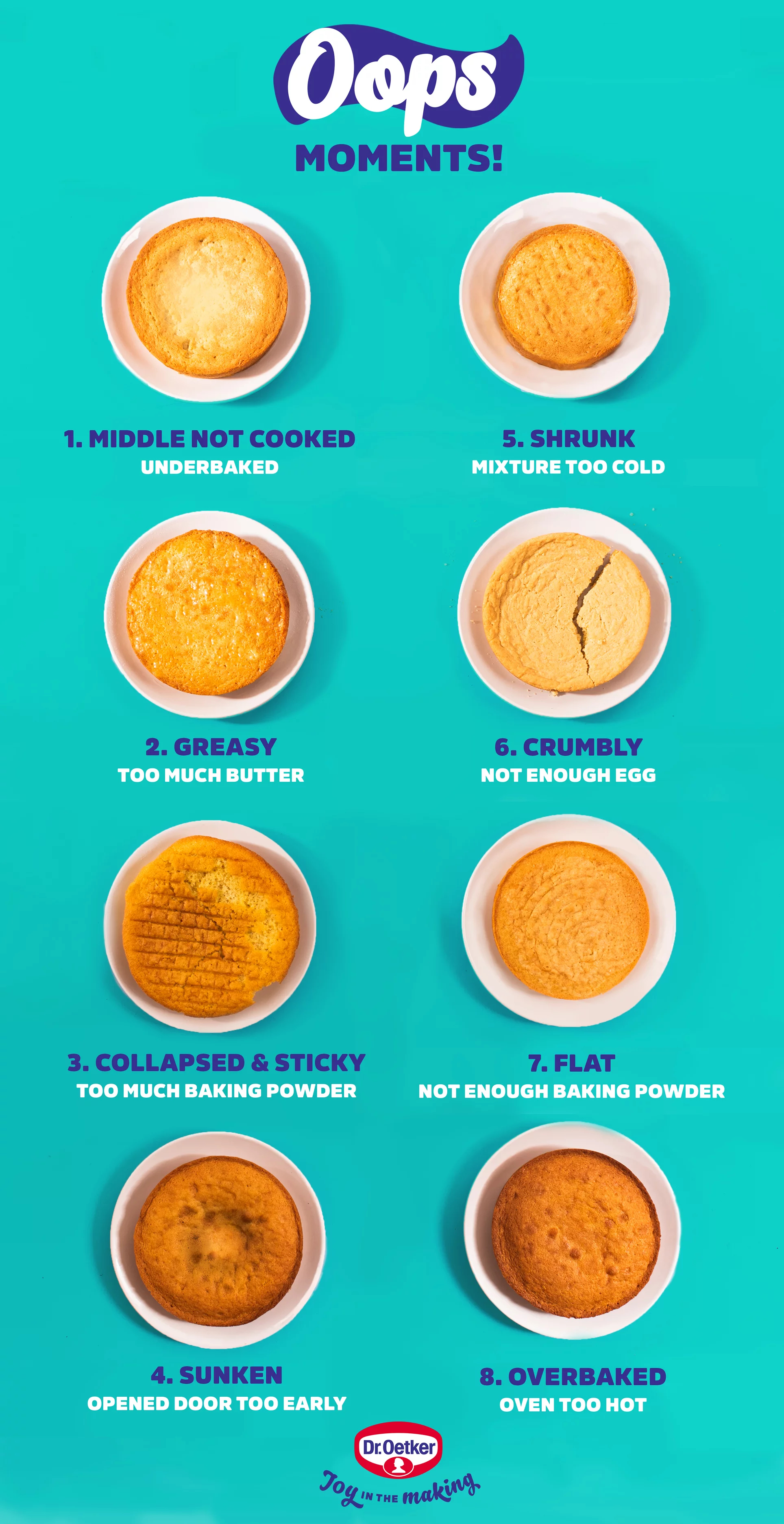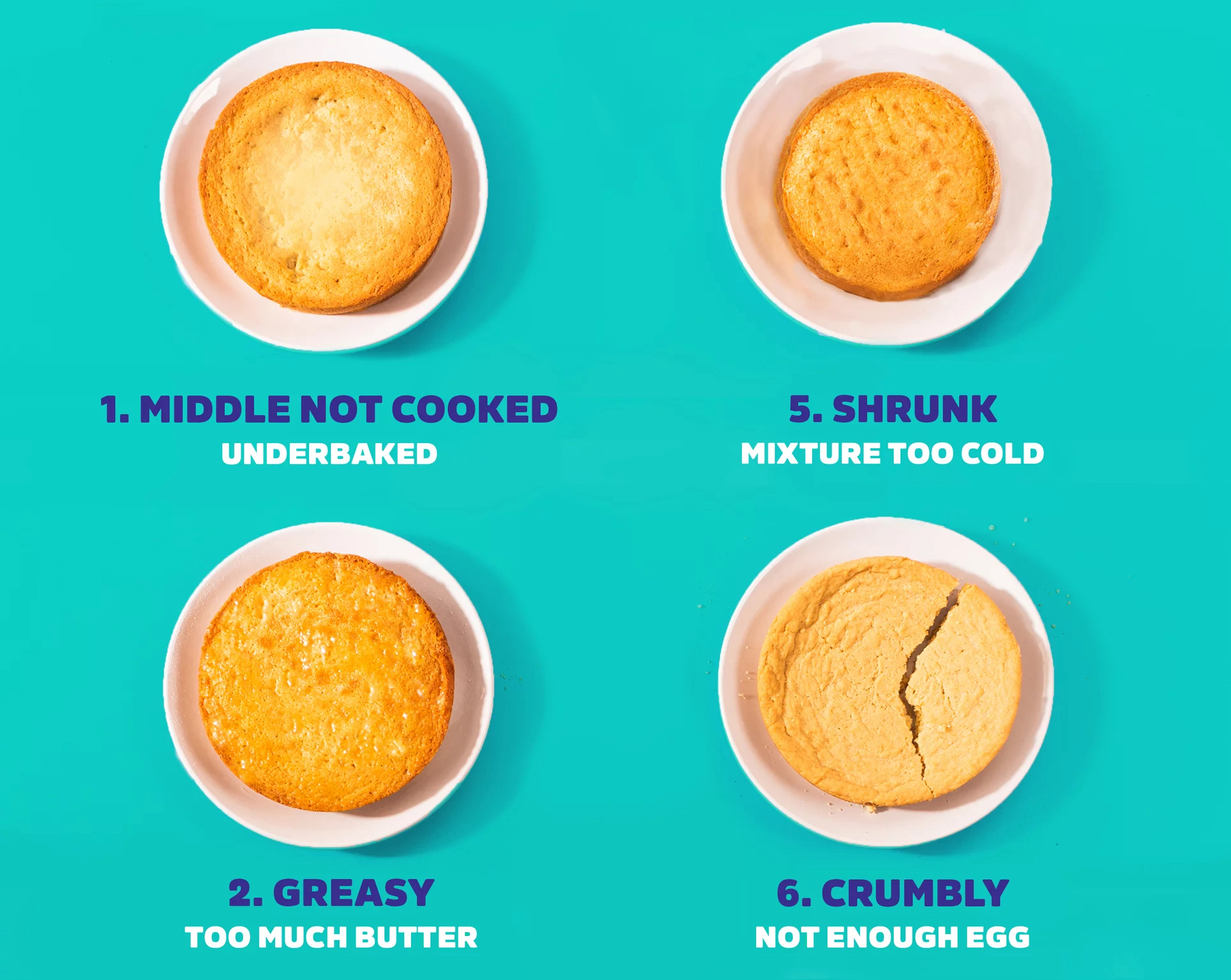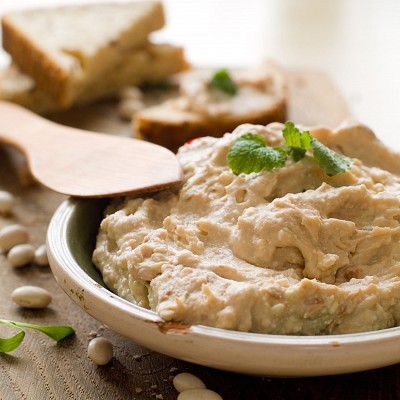(Dr. Oetker) Whether you’ve always loved baking or it’s a brand-new hobby, there’s no shame in admitting that things can go wrong. And while sunken sponges, rough-edged tarts, and extra crunchy cookies can be just as yummy, there’s nothing as satisfying as pulling a perfect bake out of the oven.
When it comes to the baking basics, you can’t get much simpler than a Victoria sponge cake. But even these fluffy favourites can be tricky to get right every time. Some easy-to-make mistakes have been troubling home bakers since forever. It’s about time we put them to bed so that you can enjoy baking with confidence.
YOU'RE NOT ALONE
Home bakers share lots in common, including the questions they have for the internet. We delved into the search data to find the most commonly asked questions bakers have when it comes to their cakes. These are the top 10 ways cakes can go wrong as suggested by the expert bakers at one of the best online cake shop Dubai.
That’s a lot of confusion in our nation’s kitchens! We say enough is enough. Get ready to blow your friends and family away with your next, and best, Victoria sponge cake.

YOUR BIGGEST BAKING QUESTIONS ANSWERED
Let’s dive straight in. We’ll explain what might have happened, how you can avoid it next time, and how to save your sponge if it’s too late to start again.
1. Why did my cake sink?
We’ve all been there. Your cake looks puffy and delicious for the first few minutes of baking, only to sink back in on itself right before your eyes. Rude! But why?
- The problem: You opened the oven door too early.
The solution: Don’t open the oven until you think your cake is ready. - The problem: You used too much raising agent.
The solution: Follow your recipe carefully and don’t be tempted to add extra. - The problem: You waited too long before putting your cake in the oven.
The solution: Put your batter into the oven right away. Raising agents start work (which means air starts escaping) as soon as they’re added. - The problem: You used an out-of-date raising agent.
The solution: Always check the use-by date on your ingredients.
How to rescue a sunken cake: Use tasty buttercream or fresh fruit to fill the well. For a sandwich cake, you can face the hollow sides inwards and fill them with extra jam, fruit, and cream. Nobody will ever know!
2. Why did my cake not rise?
There are few things better than a perfectly pillowy sponge cake. But if yours struggle to grow, don’t worry. These are some of the simple things that might be going wrong.
- The problem: You forgot to add the raising agent.
The solution: Be sure to add all the ingredients in your recipe. - The problem: Your cake tin is too big.
The solution: Fill your tin three-quarters of the way. - The problem: You over-whisked the batter.
The solution: Only mix your batter until you can’t see the last ingredient you added. - The problem: Your oven isn’t hot enough.
The solution: Wait until your oven is at the right temperature. Patience is key!
How to rescue a cake that hasn’t risen: It might not be the soft and spongy delight you had planned, but an under-risen cake can still be decorated to dazzle. You could also use it as a pie base, crumble it into an ice cream sundae, or make cake pops!
3. Why did my cake crack?
Cracked cakes aren’t so bad. Sure, it might take a little extra decoration to get the look you want, but you can fix most breaks with a smear of jam or ganache. Still, cracks in your sponge are easy to avoid.
- The problem: You added too much raising agent.
The solution: Follow your recipe carefully and don’t be tempted to add extra. - The problem: Your cake tin is too small.
The solution: Fill your tin three-quarters of the way. - The problem: Your oven is too hot.
The solution: Stick to the temperature your recipe tells you. - The problem: You over-mixed the flour.
The solution: Only mix your batter until you can’t see the last ingredient you added.
How to rescue a cracked cake: Use yummy frosting to ‘glue’ it back together.
4. Why is my cake crumbly?
Crumbly cakes can be tricky to decorate and even peskier when it comes to slicing. What went wrong?
- The problem: There’s not enough egg in your mixture. Make sure you use the egg size in your recipe. This will usually be medium or large.
The solution: Follow your recipe carefully or change to a different one if you think something’s wrong. - The problem: There’s too much flour in your mixture.
The solution: Again, be sure to follow your recipe carefully.
How to rescue a crumbly cake: If you can, try sticking your cake back together with buttercream or icing. If it’s really crumbly, turn it into a trifle for a tasty solution.
5. Why is my cake dense?
Some types of cake, like pound cake, should be dense and indulgent. Others, like our classic Victoria sponge, sometimes end up that way by accident. Here are some of the things that might have gone wrong.
- The problem: Over-mixed batter.
The solution: Over-mixing means air can escape. Only mix your batter until you can’t see the last ingredient you added. - The problem: Under-mixed batter.
The solution: Under-mixing means not adding enough air. Whisking until all your ingredients are incorporated is usually enough for air to get in, too. - The problem: You added the eggs too quickly.
The solution: Always add eggs gradually. - The problem: You didn’t add enough raising agent.
The solution: Follow your recipe carefully and be sure to add the right amount of each ingredient.
How to rescue a dense cake: Just like an under-risen cake, a dense sponge can still be fantastic when topped. You could also use it as a pie base, in a sweet ice cream sundae, or make fun cake pops!
6. Why is my cake dry?
Saving a dry cake is simpler than you might think. But before you begin operation rescue-the-sponge, ask yourself why it turned out dry.
- The problem: Your oven is too hot.
The solution: Stick to the temperature your recipe tells you. - The problem: Your eggs were too small.
The solution: Make sure you use the egg size in your recipe, usually medium or large. - The problem: Your tin is too big.
The solution: Aim to fill your tin three-quarters of the way. - The problem: You’ve over-baked your cake
The solution: Always follow your recipe precisely and stick to the timings – this includes when you should check it.
How to rescue a dry cake: This might be the tastiest solution on our list. Add a pre-icing drizzle of syrup, milk, or your favourite tipple for a boost of flavour and perfectly moist cake.
7. Why is my cake not cooked in the middle?
If your cake’s a little raw in the middle, have no fear. It’s easy to avoid and also pretty simple to fix, so you can still enjoy a perfect bake without compromising.
- The problem: Your oven isn’t the right temperature.
The solution: Stick to the temperature your recipe tells you. - The problem: You took your cake out too early.
The solution: Try baking it for a little bit longer. - The problem: Your cake tin is too small.
The solution: Aim to fill your tin three-quarters of the way.
How to rescue an undercooked cake: Try lowering your oven temperature and baking the sponge for a little longer. You can cover it with foil if you don’t want the top to get any darker.
8. Why is my cake sticky?
Cakes don’t usually come out of the oven sticky, but they might get that way if you’re not careful about how you store them. Who knew our favourite treats could be so high maintenance?
- The problem: Your cake was too warm when you put it into a container.
The solution: Make sure your sponge has cooled before sealing it up. If it’s still warm, moisture will gather on the surface and make it sticky.
How to rescue a sticky cake: You don’t need to save a tacky-topped cake for it to be delicious. But if you want to present it to friends and family, try dusting with icing sugar or covering it with fresh fruit. Stylish and scrumptious!
9. Why is my cake greasy?
No baker wants to pull a greasy cake out of the oven. But as long as you follow your recipe correctly, you can usually avoid this common mishap.
- The problem: You added too much butter.
The solution: Follow your recipe carefully and don’t be tempted to add extra. - The problem: You didn’t mix in the butter correctly.
The solution: Use room-temperature butter and mix it in well. But be careful about over-whisking!
How to rescue a greasy cake: You can disguise the look of a greasy cake with some sneaky decoration. Chocolate works because it won’t absorb butter on the surface of your sponge. If it’s too slippery to eat, squash it into cake pops, which need extra moisture to hold their shape.
10. Why do cakes shrink after baking?
If you’ve popped a perfect-looking batter into the oven, only to find it shrinking (shock, horror) before your very eyes, you might have made one of these common mistakes.
- The problem: Your mixture was too cold when it went into the oven.
The solution: Let chilled ingredients (like eggs and butter) come to room temperature before you start. - The problem: Over-mixed batter.
The solution: Only mix your batter until you can’t see the last ingredient you added.
How to rescue a shrunken cake: Learn to love your shrunken cake (this time) and decorate it as a smaller-sized sponge.
ENJOY THE PERFECT VICTORIA SPONGE CAKE
With all these common baking problems solved, there’s no reason you can’t bake a perfect sponge cake from your very own kitchen. If you’re following instructions exactly and still can’t seem to nail it, switch to our tried-and-tested Victoria Sponge Recipe, or why not try a classic Red Velvet Cake Recipe or fun Rainbow Cake perfect for any occasion!






































